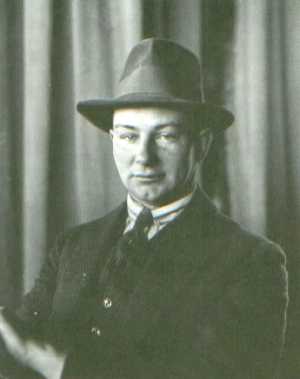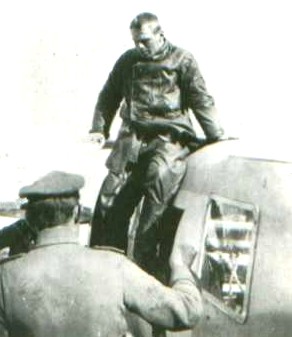|
The
Fokker scourge

Anthony
Fokker's first aircraft was a monoplane he called "Die
Spinne" ("The Spider").
Anthony Fokker was born in Java on April 6, 1890, to
Dutch parents. He learned the basics of
aeronautics at a technical
school in Mainz and built his first plane in 1910.
By 1913, he had established
a small factory and a successful flight school at Schwerin,
one hundred miles (16 1km)
northwest of Berlin. He was to become one of the most
interesting and controversial figures
in the history of aviation. Fokker’s career in
aeronautics lasted until his death
in New York City on December 23,
1939.
Fokker was accused of copying the designs
of others; in fact, he was an admirer of Morane- Saulnier
planes and based many of his aircraft on their lines. His
Oberursel engine in his planes was a virtual copy of the
French Gnome engine. He was accused of fabricating tall
tales, such as the story he told about taking the propeller
off Garros’ captured plane and single-handedly concocting the
mechanism of his landmark Eindekker (single wing) E.I in a
marathon forty-eight- our session of frantic engineering.

Max Immelmann is pictured here in front of the Fokker
E.I Eindekker,
a plane that was not particularly fast or manoeuvrable, but
had the
distinction of having the first synchronized machine
gun and propeller.
In Immelmann’s hands, the Eindekker outclassed anything in
the sky.
The fact was that he and engineer
Heinrich Luebbe had already designed a mechanism that
successfully synchronized the propeller with the firing of a
machine gun, and had ins. Fokker produced forty different
types of aircraft during the war (all designed by a team led
by his chief engineer, Reinhold Platz), and after
the war produced the planes that formed the basis of the
commercial aviation industry of the 1920s and 1930s. talled it on one of his aircraft.
His mechanism had nothing whatever to do with the Garros-Saulnier device, and Fokker promoted the tall tale to
hide the fact that he had also offered his invention to the
Allies (who turned him down)
The first Fokker E.Is reached the front in the summer
of 1915, and two fliers in particular showed a
facility in handling the new system: Oswald Boelcke, a
flier whose exploits as a reconnaissance aviator in an
Albatross spotter plane had already earned him the
Iron Cross; and Max Immelmann, known as “The Eagle of
Lille,” after the town in northern France over which
he often prowled.
He was a husky, athletic man who could barely fit in
the E.I’s pilot’s seat. These two men formed the core
of the squadron Jagdstaffel (fighter-squadron) Nr. 2
(contracted to Jasta 2), and became the most
celebrated aces in the last six months of 1915, during
which the Fokker planes had unchallenged control of
the skies.
Boelcke and Immelmann often flew together displaying an
uncanny coordination. Yet they were very different
people. Immelmann was a lonely moody and
given to fits of anger, brooding and undisciplined. He
sometimes used acrobatic turns to outflank an enemy
flier. One such manoeuvre, a combination loop and
half-roll that gives the pilot a quick second pass at
a target, is called the “Immelmann turn” (though he
never mentioned the manoeuvre in any of his letters
and the turn was already a staple among stunt fliers
before the war).
Boelcke was a teacher before the war and, though he
thought of himself as a lone knight, he also
understood the importance of coordinated and
disciplined attack.
He was an outgoing leader of men, a bon vivant who
often took young women for rides in his airplane and
who enjoyed the finer things. Boelcke shared his knowledge
and experience, and trained many of the fliers who
were to become aces later in the war. Yet, Boelcke and
Immelmann were like-minded in their beliefs about how
the Fokker planes should be used.

Anthony Fokker looked even
younger than twenty-five, his age
when he rose to the top of Germany’s military aircraft
program—and he
was not German. The executives and
engineers at Albatross had to
swallow hard taking orders
from the young upstart. But the key to
Fokker’s success
was that he sought the advice and
friendship of the aces
who flew the planes, including Oswald
Boelcke a master
flier and tactician of the World War l
They took an aggressive approach, ignoring directives
that forbade them from chasing Allied planes across
battle lines. For their leadership in clearing the
skies of Allied planes, Boelcke and Immelmann were
awarded the Ordre Pour le Merite, a medal that became
known as the Blue Max (after Lmmelmann), Germany’s
highest military honour, established by Frederick the
Great in 1740 (when French was the language of the
court) and previously awarded only to generals
responsible for winning wars. By the end of the war,
eighty-one fliers were awarded the Blue Max (much to
the consternation of the highest ranking generals or
the far fewer prewar recipients still living at the
time), making the flier the most glorified soldier
since the Middle Ages. Boelcke and Lmmelmann died
during in-flight accidents in 1916, and both received
funerals fit for a Wagnerian hero.

Few
aircraft of the World War I period have received the
attention given the Fokker Dr.I triplane. Often linked
with the career of the highest scoring ace of that
war, Germany's Rittmeister Manfred von Richthofen, the
nimble Dr. I earned a reputation as one of the best
"dogfighters" of the war.
By the summer of 1915, German control of the skies
allowed its ground forces to fend off every Allied
offensive and to mount the assault on Verdun in
February 1916, exacting a great toll in Allied
casualties and throwing the Allies into disarray.
Continued Allied efforts to duplicate the Fokker
firing mechanism proved difficult, and by the time
better-performing Allied planes came off the
production lines, the German aces had accumulated
valuable combat experience—and an invaluable
psychological edge.

The
Fokker D.VII was unquestionably the best all-round
German fighter of WWI.
Realizing Fokker’s potential, the German government
naturalized him in 1916 and forbade him to leave the
country. For the rest of the war, he continued
designing some of the most dangerous combat airplanes
of the war, including the Dr.1 Dreidecker (made famous
by Manfred von Richtofen, the "Red Baron") and the
D.VII, the first airplane specifically designed for
aerial combat. When the war ended, the D.VII was the
only weapon the Treaty of Versailles specifically
ordered to be destroyed.

Manfred von Richtofen after a mission |
